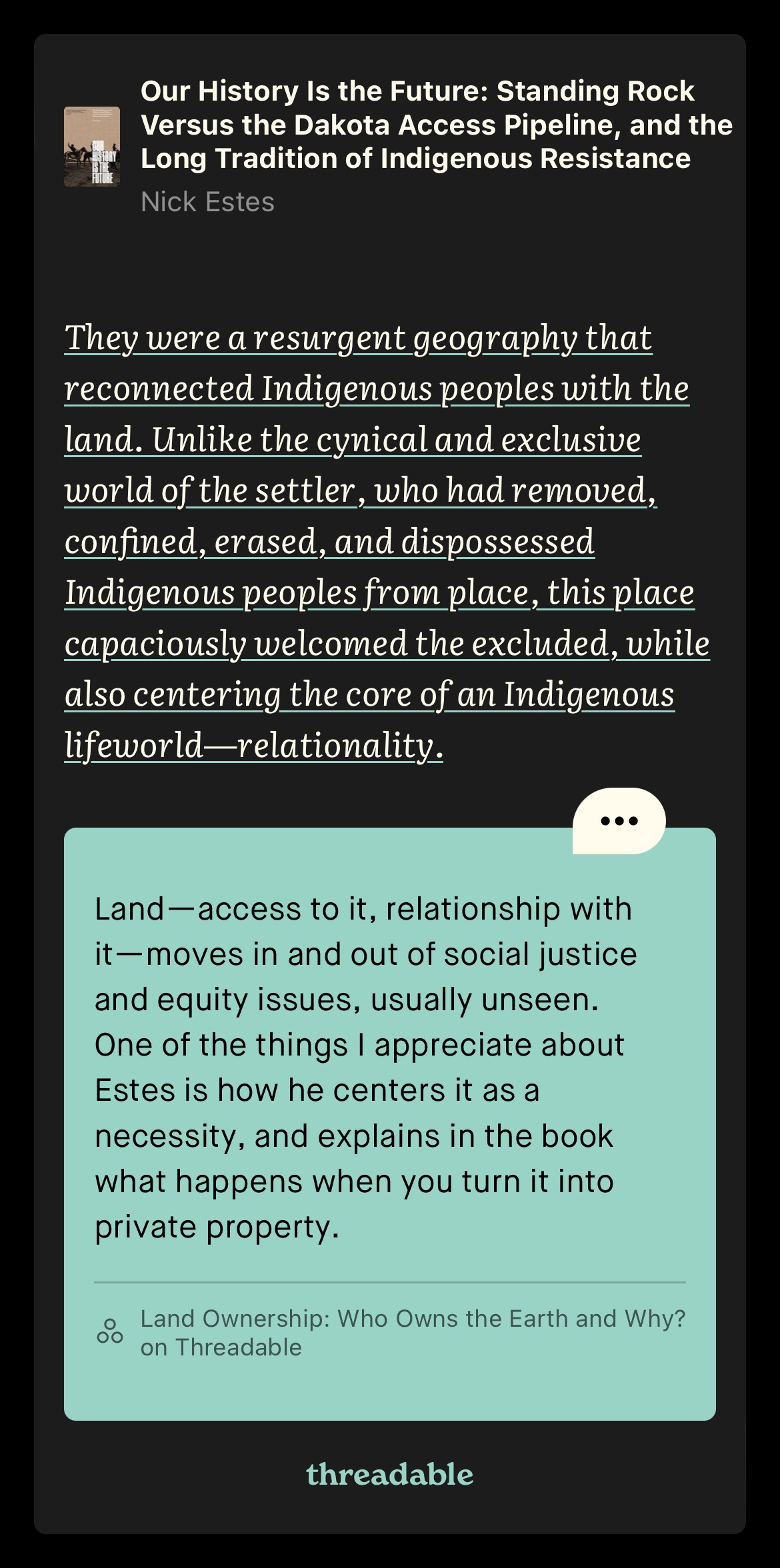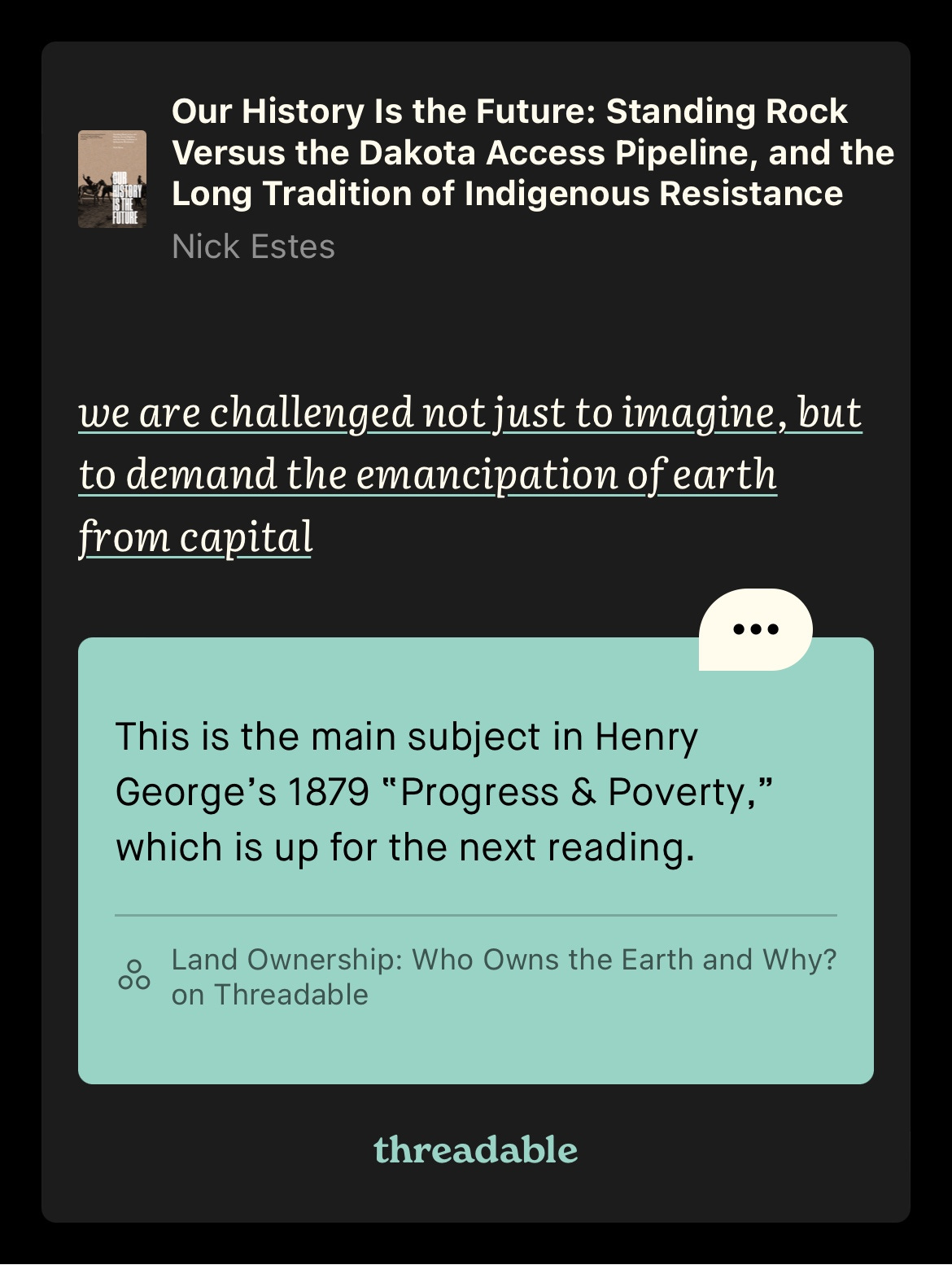Reading "Our History Is the Future: Standing Rock Versus the Dakota Access Pipeline, and the Long Tradition of Indigenous Resistance," by Nick Estes
Threadable-adjacent reading discussion on land ownership
The most recent Threadable reading* for Land Ownership was a selection from Nick Estes’s book Our History Is the Future: Standing Rock Versus the Dakota Access Pipeline, and the Long Tradition of Indigenous Resistance, from the middle of Chapter 6: Internationalism, to the end of Chapter 7: Liberation, pages 242-257.
*(https://threadablenative.page.link/Rxp8yegeZ1vXy4u19 if you want to try the Threadable app and need the link! Only works on iOS/Apple devices for now.
For anyone new to On the Commons an overview of this project is here. These Substack posts are for anyone who doesn’t have iOS or doesn’t want to use Threadable but still wants to know about the readings; the subtitles are marked with “Threadable-adjacent reading discussion on land ownership.” Please feel free to comment or email me with any questions.)
Unfortunately, I couldn’t find any excerpts of this section online. However, about 37 minutes into this talk, Estes reads a solid chunk of the final chapter. But I also think this is an important book, even a vital one, and if you can read the whole thing, I recommend it. (Credit to Chris La Tray for recommending ages ago that I move it up my TBR pile.)
“In 1980, the US Supreme Court confirmed the Oceti Sakowin’s claim that the Black Hills had indeed been stolen. ‘A more ripe and rank case of dishonorable dealing will never, in all probability, be found in our history,’ the ruling stated. As a result, the court awarded a $106 million settlement. The Oceti Sakowin responded nearly unanimously under a popular slogan: ‘The Black Hills are not for sale!’ In the spirit of Standing Rock and the Treaty Council’s original 1974 contention, they considered a full restoration of the illegal taken lands to be the only just solution. And this gets to the heart of the matter. The Oceti Sakowin’s struggle for is land is not about getting reparations, apologies, or reconciliation. It is about justice and ending the settler-colonial system.”
I started the Threadable reading selection at this passage in Chapter 6 because it immediately poses the question of justice, both when it comes to land theft and when it comes to land ownership. The Black Hills, like most other land in North America, were stolen. I personally cannot imagine having had that happen, and happily accepting cash as recompense. They’re not equivalent.
Which really, although Estes doesn’t directly address this often in the book, gets to part of the heart of the issue with land ownership. Forcing people into a market relationship with land steals away something that is bigger than money, more intangible and more important and impossible to restore without restoring the land itself.
Our History Is the Future was one of the first books I read that got straight to the point of the American project: acquisition and privatization of land. The section I chose for the Threadable reading is just one that addresses some of the consequences of these efforts, and what resistance might look like going forward and internationally, but many different sections could have taken its place. Estes writes incisively about the fundamental incompatibility between a collective-oriented form of land relationship, and the colonial project of privatization—one that will be familiar for those who read some of Andro Linklater’s Owning the Earth. It was an extension of same project that led to mass starvation, displacement, and civil unrest in Britain starting particularly in the 1400s with enclosures of the commons. Take that which is common to all, managed by all, relied on by all, and fence it off for one owner’s private profit.
In the Americas, this was combined with the government’s and settlers’ hunger for land that they saw as open to claim, except for the people they saw as being in the way, or as holding “progress” back:
“There is one essential reason why Indigenous people resist, refuse, and contest US rule: land. In fact, US history is all about land and the transformation of space, fundamentally driven by territorial expansion, the elimination of Indigenous peoples, and white settlement.”
In an hour-long presentation Estes gave on the book, he explained its structure as tracing four separate invasions into Indigenous land and life across North America: the fur trade, elimination of the buffalo, the 1944 Pick-Sloane Plan (a series of dams that forced relocation of many Native American communities; it was part of a project to continue forcing assimilation), and the recent North American oil boom. (I did wonder why the Dawes Act and forced allotment wasn’t considered a separate invasion as well, but he didn’t address it in that particular talk.)
The recent oil boom is particularly interesting to think of as an invasion because toward the end of Our History Is the Future Estes makes a point of noting whose property rights were protected at Standing Rock and elsewhere—the pipeline company’s. Which is a demonstration of obvious and ruthless injustice, but also, to me, of a truth that so many people try to ignore: private property rights depend on whose values and whose property is being defended at any given period in time, and they’re subject to change. There is nothing in fact reliable about property rights, no matter how immutable they might feel.
Which goes back to some of the legal history covered in particular in In the Courts of the Conqueror, a book covering ten legal cases, all of which demonstrate that property rights depend not on an abstract legal conception of those rights themselves, but on who holds them and how they benefit. When we’re talking about the colonization of North America, land—and who gets to live on it—were, and are, determined not by rights but by who wanted it and who has been willing to use power, dishonesty, subterfuge, and repeated violence to take possession of it.
“To carry out the land cessions, the US government needed settlers to hold private property in perpetuity. Private ownership (or “fee simple”) is seen, under US law, as the highest possible form of ownership, while Indigenous occupancy is seen as temporary; thus, collective Indigenous ownership and use could be dissolved for private ownership, but not the other way around. But because private property is exclusive, the two systems of land tenure fundamentally could not overlap.”
In that talk I linked to, Estes said that he thinks of “Standing Rock as a decolonization movement for North America.”
That project is going to require far more than acknowledgments or any other kind of easy nod to past and ongoing wrongs that leave the compounded injustices intact. Estes referred in the book to several instances of failures of imagination on the part of courts and settlers regarding how we could live without colonialism, especially in relation to land, failures that demonstrate “a limit to the project of settler justice,
which can extract an admission of wrongdoing, but cannot reorder the world or redistribute wealth, especially land, back to its rightful owners.”
But admissions of wrongdoing simply aren’t enough. “Under capitalism,” he wrote, “neither Democrat nor Republican can save Indigenous lands or Black and Indigenous lives.” The values prioritized by private property law and commodification, underpinned by a paradigm of ownership, won’t allow it, just as they won’t allow many other things that truly matter.
There is so much more in this book, and I highly recommend people pick it up and read it, or at a minimum look for more talks and papers from Estes. I really don’t think we can make progress on almost any front of justice without scraping down to the true bedrock of not just North America, but many continents: The land was stolen.
This will be the subject of the next reading, an excerpt from Henry George’s 1879 book Progress & Poverty, the section in which he makes the case that private land ownership is absolutely unjust, and in fact more so the longer it’s owned because its injustices are compounded.
“We are challenged not just to imagine, but to demand the emancipation of earth from capital,” wrote Estes.
George did. And he came close to succeeding.







Saw a post on Twitter just now about the Nederlander monument in lower Manhattan. Since I can’t post the screenshot here, I’ll put it in our group chat. Another false story of an indigenous leader who agreed to “sell” land.
As I understand the traditional Native American point of view, it is not so much that they want land "back," per se, but that they want it out of private ownership and returned to the commons.
Does this sound right?